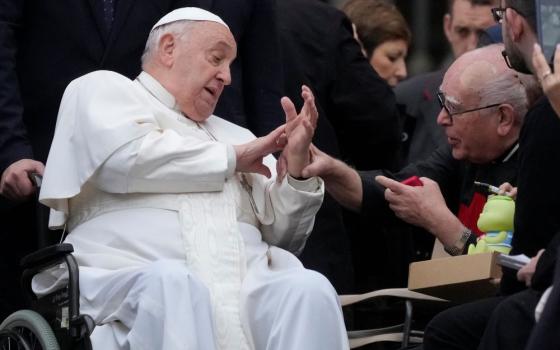Last year, at the annual USCCB plenary, Archbishop Joseph Kurtz, president of the conference, delivered his first presidential address. What stood out like a sore thumb was the fact that, although the text mentioned the importance of the Theology of the Body, it failed to mention anything about immigration. This, despite the fact that Pope Francis’ first trip outside of Rome had been to Lampedusa, where many migrants had been killed trying to cross by boat into Europe, the pope had spoken about the issue repeatedly and powerfully, the USCCB’s own Committee on Migration had conducted a Mass at the border, led by Cardinal Sean O’Malley, that received enormous and favorable media coverage, and the issue was still on the political radar screen. Speeches like this are the result of long staff work, and the fact that the Theology of the Body made it into the text and immigration did not gave everyone some indication that the conference’s agenda and the pope’s were not exactly on the same page.
A little more than one month ago, Pope Francis spoke to the U.S. bishops gathered in St. Matthew’s Cathedral. There, he confronted the dominant culture warrior approach the USCCB too often has displayed, most notably this year in their reaction to the Supreme Court decision on same sex marriage. The pope said, “Harsh and divisive language does not befit the tongue of a pastor, it has no place in his heart; although it may momentarily seem to win the day, only the enduring allure of goodness and love remains truly convincing.” As I noted at the time, you could literally hear one of the EWTN commentators gasp as he spoke those words. Later in the talk, the pope offered a different, less confrontational model: “Dialogue is our method, not as a shrewd strategy but out of fidelity to the One who never wearies of visiting the marketplace, even at the eleventh hour, to propose his offer of love (Mt 20:1-16). The path ahead, then, is dialogue among yourselves, dialogue in your presbyterates, dialogue with lay persons, dialogue with families, dialogue with society. I cannot ever tire of encouraging you to dialogue fearlessly. The richer the heritage which you are called to share with parrhesia, the more eloquent should be the humility with which you should offer it.”
One week from today, the USCCB opens its 2015 plenary. The bishops have the opportunity to demonstrate that they heard the Holy Father, that they have caught some of the new winds blowing in the Church under Francis. Or, they can continue down a different path, one that has marginalized their influence in Washington and made them appear thoroughly out of touch with their own flocks. The sad and regrettable fact is that the USCCB of late has acquired only the smell of the neo-conservative, upper middle class Catholic sheep and the Republicans for whom they vote. Will the bishops be prepared to stretch, to accept the challenge Pope Francis poses to them and their style of leadership, as Archbishop Aymond framed it on PBS.
The bishops have to choose and their choice will be evident in three agenda items next week.
First, the bishops must adopt a new set of priorities for the coming years. In June, when they discussed this issue, some bishops were remarkably frank in voicing their sense that the priorities, as proposed, were inadequate. “I want to express my disappointment. I really do believe that there needs to be much greater visibility given to the plight of the poor, the economic disparity that so many families feel, rural poverty, joblessness, the struggle of the working poor,” said Bishop George Thomas of Helena, Montana. “And I’d like to think that as these priorities evolve, that there would be much greater visibility and emphasis in the conference, and the body of bishops would throw our collective weight behind a voice of advocacy for the poor in America.” Bishop Christopher Coyne of Burlington, Vermont, said that the proposed priorities made it look like “we’ve been doing the same thing we’ve always done.” And Archbishop Joseph Tobin made the disconnect with Pope Francis explicit, saying, “Now, I’m not sure how the points of emphases work, but I would argue that the newness of Francis should condition in a very visible way the priorities as such, so it’s clear that we take him seriously and we’re accepting his pastoral guidance.”
The current list of priorities are: family and marriage; evangelization; religious freedom; human life and dignity; and vocations. If these stand as presented, the conference will have given a thumbs down to Pope Francis’ leadership. There is no reason that they do not combine religious freedom with evangelization and, following on the way the pope framed the issue of religious liberty during his talk at Philadelphia’s Independence Hall, link both to inter-religious dialogue. Human life and dignity should be expanded to explicitly include care for creation. Family life and marriage are themselves vocations, and that combination could be effected so that room was created for the plight of the poor and the immigrants among the five priorities for the conference. The debate on these priorities and plans may be the most explosive of the entire conference.
The second area where a new direction is needed is on the bishops’ quadrennial election year statement “Faithful Citizenship.” Four years ago, the bishops left the main text in tact and added an introductory note. I regretted the fact that the bishops’ 2012 text was not altered to include the developments in the Church’s teaching represented by Pope Benedict XVI’s Caritas in Veritate, issued in 2009, which was a wonderful encyclical. Now, with both Evangelii Gaudium and Laudato Si’ it is unthinkable that the bishops’ conference did not find the time or the inclination to adapt the text significantly. In the former, Pope Francis emphasized the importance of considering structural sin, and in the latter, he developed the concept of integral ecology. These both should serve as a counter-balance to the current text’s emphasis on intrinsic evil. Failing to introduce them into the text’s treatment of conscience formation would send the clear signal that the USCCB is not on the same page as the pope.
It will be interesting to see how the USCCB treats the subject of the environment. The fact that this was the subject of the Holy Father’s first encyclical, that it was a repeated theme of his during his many speeches in the U.S., should certainly suggest a robust treatment. As well, how will the conference deal with the issue of same sex marriage? There is a disagreement among our conservative friends between those who continue to think that same sex marriage is the hill on which the Church should fight and die. Saner conservatives think the Church needs to figure out how to adjust to maintaining its mission in a culture that has a very different understanding of marriage from that of the Church, a difference that has been clear for decades, at least since the introduction of no-fault divorce laws. The different approaches were evident in the way different bishops addressed the Supreme Court’s decision in June. And, while the section on poverty in previous iterations of the text was very strong, the issue is so central to understanding not only the Church’s role in society, but the Church’s own sense of herself, this section should be strengthened with the many powerful statements Pope Francis has made.
Finally, the divisions within the conference, and the direction they wish to pursue, will be evident in the elections of committee chairs and a new General Secretary. My colleague Tom Reese wrote about the committee chair elections, although I think he overstated the significance of which nominees had been selected by Pope Francis. For example, it seems clear that Bishop Frank Caggiano has a different style and approach from that of Archbishop Charles Chaput, the two men contending to lead the Committee on Marriage and Family Life. It is true that Pope Francis did technically appoint +Caggiano but the appointment came in the early months of Francis’ pontificate and when Cardinals Burke and Rigali were still on the Congregation for Bishops. I suspect +Caggiano could do a better job explaining whatever document Pope Francis produces after the Synod on the Family. But, the fact that Francis appointed him is not the key to understanding the differences between the two men.
In some of the elections, I would flip a coin. Archbishops Jose Gomez and John Wester would both be great as chairs of the Committee on Migration. Archbishop Robert Carlson and Bishop George Murry would both be great as chairs of the Committee on Education. I suspect that the body will select San Diego Bishop Bob McElroy as chair on the Committee on Domestic Policy. On issues of public policy, he is probably the smartest man in the room. The really interesting committee chair race will be between Denver Archbishop Samuel Aquila and Indianapolis Archbishop Joseph Tobin to lead the Committee on Clergy, Consecrated Life and Vocations. Here is a clear contrast between the culture warrior style of +Aquila and the dialogical, engaged style of +Tobin.
The contest for the next General Secretary is very important, but I have not seen a press release so much as announcing the candidates. Last year I wrote about the low morale at the conference, the loss of very fine staff, and their replacement with people of a very strong ideological character. If anything, the situation is worse now than it was then. Unless there is a clear change in direction, one source told me, we should expect a significant number of key staffers to head for the exits. The fact that the nominees have not even been announced makes predictions impossible. But, in the past ten years, the conference has not only faced deep internal morale problems, but their clout within Washington has been greatly diminished as they have become perceived as an arm not just of the Republican Party but of the Amen Corner of the LifeSiteNews brigades. If the bishops are satisfied with that result, they will certainly be able to preserve the status quo. If they are offered the option of indicating a change in direction, they should take it.
Today is the Feast of the Dedication of the Lateran Basilica, the mother and head of all churches. The bishops of the United States, mindful of all that was taught by the Second Vatican Council about the role of bishops and the structure of the Church, nonetheless need to decide if they are going to be “cum Petro et sub Petro” or not. There was a time when resistance to a pope could be kept quiet, but that time has passed. The interventions at the synod by some of the U.S. delegates, to say nothing of the fact that two U.S. cardinals signed that disgraceful letter to the pope, demonstrated the resistance for all to see. The rest of the bishops need to decide which direction they want to go. And, as always, NCR will be on site and covering the meeting in real time.



